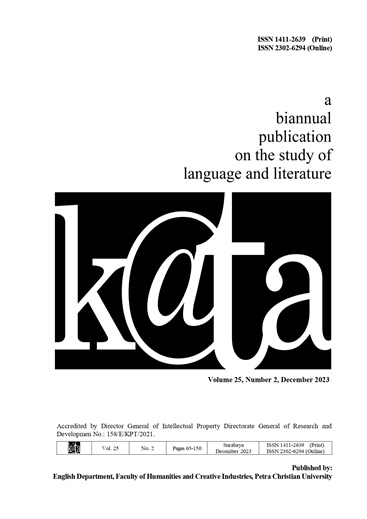Ideological Ambivalence: A Social Semiotic Multimodal Analysis of LGBT Activism in @WhatIsUpIndonesia
Abstract
Many people have attempted to criminalize the LGBT community. This study aims to examine how @WhatIsUpIndonesia negotiates the supported ideology with the dominant ideology in their Instagram posts about criminalizing LGBT people through two different cases; the proposed revision of Indonesia's Criminal Code (RKUHP) and Bogor’s Regional Regulation on the Prevention and Countermeasures Against Sexually Deviant Behavior. A corpus of two posts about the two cases is analyzed using social semiotic multimodal analysis in two steps: textual analysis and visual analysis. This study finds that WIUI negotiates its relatively liberal values with the dominant conservative ideology in Indonesia by choosing ambivalence through the shifting focus and overgeneralizing the issue using recontextualization and memes. In conclusion, two opposing ideologies in social media activism can be negotiated using ambivalence instead of leaning towards only one. However, the limitations of this research prevented a thorough examination of how WIUI interacts with its audience.
Downloads
References
Anapol, A. (2022). Stay alert, control the virus, make memes: A multimodal discourse analysis of UK internet memes during the COVID-19 pandemic. In S. Tan & Marissa K. L. E. (Eds.), Discourses, modes, media and meaning in an era of pandemic (1st ed., pp. 227–244). New York: Routledge. https://doi.org/10.4324/9781003168195-16
Baker, J. E., Clancy, K.A., & Clancy, B. (2020). Putin as gay icon? Memes as a tactic in Russian LGBT+ activism. In R. Buyantueva & M. Shevtsova (Eds.), LGBTQ+ activism in Central and Eastern Europe: Resistance, representation and identity (1st ed. 2020, pp. 209–233). London: Palgrave Macmillan. https://doi.org/10.1007/978-3-030-20401-3
Fubara, S. J. (2020). A Pragmatic analysis of the discourse of humour and irony in selected memes on social media. International Journal of Language and Literary Studies, 2(2), 76–95. https://doi.org/10.36892/ijlls.v2i2.281
Grundlingh, L. (2018). Memes as speech acts. Social Semiotics, 28(2), 147–168. https://doi.org/10.1080/10350330.2017. 1303020
Horvath, G. (2021). Internet memes and a female “Arab Spring”: Mobilising online for the criminalisation of domestic abuse in Hungary in 2012-13. Feminist Media Studies, 23(3), 819–835. https://doi.org/10.1080/14680777.2021. 2010787
Howard, V., & Adan, A. (2018). The end justifies the memes: A feminist relational discourse analysis of the role of macro memes in facilitating supportive discussions for victim-survivors of narcissistic abuse. Cyberpsychology: Journal of Psychosocial Research on Cyberspace, 16(4), Article 10. https://doi.org/10.5817/CP2022-4-10
Jewitt, C. (Ed.). (2009). The Routledge handbook of multimodal analysis. New York: Routledge.
Kumar, A., & Garg, G. (2019). Sarc-M: Sarcasm detection in typo-graphic memes. International Conference on Advances in Engineering Science Management & Technology (ICAESMT) – 2019. https://doi.org/10.2139/ssrn.3384025
Ledin, P., & Machin, D. (2017). Multi-modal critical discourse analysis. In J… Flowerdew & J. E. Richardson (Eds.), The Routledge handbook of critical discourse studies (1st ed., pp. 60–76). New York: Routledge.
Machin, D. (2013). What is multimodal critical discourse studies? Critical Discourse Studies, 10(4), 347–355. https://doi.org/10.1080/17405904.2013.813770
Machin, D., & van Leeuwen, T. (2016). Multimodality, politics and ideology. Journal of Language and Politics, 15(3), 243–258. https://doi.org/10.1075/jlp.15.3.01mac
Mahadeen, E. (2021). Queer counterpublics and LGBTQ pop-activism in Jordan. British Journal of Middle Eastern Studies, 48(1), 78–93. https://doi.org/10.1080/13530194.2021.1885850
Narasi TV [Narasi]. (2022, July 7). Bongkar “Anak Jaksel” feat. What is up, Indonesia? (WIUI) Bongkar [Video]. YouTube. https://www.youtube.com/watch?v=rp0kLeJFWCQ
Paltridge, B., & Hyland, K. (2012). Discourse analysis: An introduction (Bloomsbury Discourse) (2nd ed.). New York: Continuum.
Prastiwi, E. (2021). A critical discourse analysis on LGBT on Republika online news articles. Etnolingual, 5(1), 48–70. https://doi.org/10.20473/etno.v5i1.33943
Piata, A. (2016). When metaphor becomes a joke: Metaphor journeys from political ads to internet memes. Journal of Pragmatics, 106, 39–56. https://doi.org/10.1016/j.pragma.2016.10.003
Ridwan, R., & Wu, J. (2018). Being young and LGBT, what could be worse? Analysis of youth LGBT activism in Indonesia: challenges and ways forward. Gender &Amp; Development, 26(1), 121–138. https://doi.org/10.1080/ 13552074.2018.1429103
Sheikh, M. A., Hassan, A. A., & Muzafar, H. (2022). Political satire through memes: Content analysis of Facebook pages. Online Media and Society, 3, 98–111.
Souza, T. A. De, & Passos, M. Y. (2021). Os memes em pauta: Uma análise discursiva das apropriações midiáticas do humor[Memes on the agenda: a discourse analysis of media appropriations of humor]. Intercom: Revista Brasileira De Ciências Da Comunicação, 44(1), 231–246. https://doi.org/10.1590/1809-58442021111
Utami, M. A. (2018). News media partiality concerning LGBT issues in Indonesia: A hidden agenda of The Jakarta Post and Jakarta Globe. Ranah Jurnal Kajian Bahasa, 7(1). https://doi.org/10.26499/rnh.v7i1.566
van Leeuwen, T., & Wodak, R. (1999). Legitimizing immigration control: A discourse-historical analysis. Discourse Studies, 1(1), 83–118. https://doi.org/10.1177/1461445699001001005
Verhoeven, E., Dhoest, A., & Paulussen, S. (2022). No room for hate in our country: Constructing the LGBTI-friendly nation in news discourses after the murder of a gay man in Belgium. International Journal of Cultural Studies, 136787792211310. https://doi.org/10.1177/13678779221131080
What Is Up, Indonesia? [@whatisupindonesia]. (2022a, March 23). Bogor’s regional regulation on “sexually deviant behavior”: Accused of being discriminatory towards the LGBT Community [Poster]. Instagram. https://www.instagram. com/p/CbcaKYTvcAJ/
What Is Up, Indonesia? [@whatisupindonesia]. (2022b, May 24). Is the RKHUP really going to criminalize LGBT? [Poster]. Instagram. https://www.instagram.com/p/Cd8FpY0v8Zf/
Wijaya, H., & Davies, S. G. (2019). The unfulfilled promise of democracy: Lesbian and gay activism in Indonesia. In T. Dibley & M. Ford (Eds.), Activists in Transition Progressive Politics in Democratic Indonesia (pp. 153–170). Ithaca: Cornell University Press.

This work is licensed under a Creative Commons Attribution 4.0 International License.
This work is licensed under a Creative Commons Attribution License


















